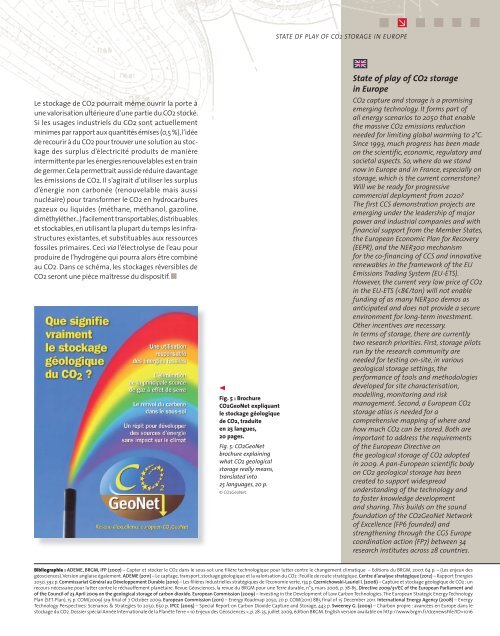revue_geosciences16
revue_geosciences16
revue_geosciences16
You also want an ePaper? Increase the reach of your titles
YUMPU automatically turns print PDFs into web optimized ePapers that Google loves.
Le stockage de CO2 pourrait même ouvrir la porte à<br />
une valorisation ultérieure d’une partie du CO2 stocké.<br />
Si les usages industriels du CO2 sont actuellement<br />
minimes par rapport aux quantités émises (0,5 %), l’idée<br />
de recourir à du CO2 pour trouver une solution au stockage<br />
des surplus d’électricité produits de manière<br />
intermittente par les énergies renouvelables est en train<br />
de germer. Cela permettrait aussi de réduire davantage<br />
les émissions de CO2. Il s’agirait d’utiliser les surplus<br />
d’énergie non carbonée (renouvelable mais aussi<br />
nucléaire) pour transformer le CO2 en hydrocarbures<br />
gazeux ou liquides (méthane, méthanol, gazoline,<br />
diméthyléther...) facilement transportables, distribuables<br />
et stockables, en utilisant la plupart du temps les infrastructures<br />
existantes, et substituables aux ressources<br />
fossiles primaires. Ceci via l’électrolyse de l’eau pour<br />
produire de l’hydrogène qui pourra alors être combiné<br />
au CO2. Dans ce schéma, les stockages réversibles de<br />
CO2 seront une pièce maîtresse du dispositif. ■<br />
Fig. 5 : Brochure<br />
CO2GeoNet expliquant<br />
le stockage géologique<br />
de CO2, traduite<br />
en 25 langues,<br />
20 pages.<br />
Fig. 5: CO2GeoNet<br />
brochure explaining<br />
what CO2 geological<br />
storage really means,<br />
translated into<br />
25 languages, 20 p.<br />
© CO2GeoNet.<br />
state of play of co2 storage in europe<br />
State of play of CO2 storage<br />
in Europe<br />
CO2 capture and storage is a promising<br />
emerging technology. It forms part of<br />
all energy scenarios to 2050 that enable<br />
the massive CO2 emissions reduction<br />
needed for limiting global warming to 2°C.<br />
Since 1993, much progress has been made<br />
on the scientific, economic, regulatory and<br />
societal aspects. So, where do we stand<br />
now in Europe and in France, especially on<br />
storage, which is the current cornerstone?<br />
Will we be ready for progressive<br />
commercial deployment from 2020?<br />
The first CCS demonstration projects are<br />
emerging under the leadership of major<br />
power and industrial companies and with<br />
financial support from the Member States,<br />
the European Economic Plan for Recovery<br />
(EEPR), and the NER300 mechanism<br />
for the co-financing of CCS and innovative<br />
renewables in the framework of the EU<br />
Emissions Trading System (EU-ETS).<br />
However, the current very low price of CO2<br />
in the EU-ETS (












